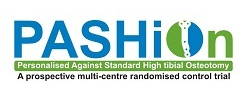PASHiOn: Personalised Against Standard High tibial Osteotomy, a prospective multi-centre randomised controlled trial
Arthritis of the knee is common. In the UK, 14% of the population over 40 suffer from knee arthritis (4.5 million people). It is a cause of significant disability and pain as well as being a financial burden. For relatively young sufferers, treatment options are limited: knee replacement carries a higher risk of failure for younger people and is not recommended at the earlier stages of knee arthritis.
High Tibial Osteotomy (HTO) is a surgical procedure to straighten the leg and reduce your knee pain. This procedure does not return the knee to normal. However, it helps relieve pain in the knee and delays the need for a total knee replacement.
Patients suitable for HTO usually have been diagnosed with arthritis affecting one side of the knee joint. During HTO surgery, the knee joint is straightened to off-load the worn areas of the knee. A surgical cut is made in the bone below the knee joint. The cut is then stabilised by a metal plate and screws (like in the image above).
The operation is usually performed using x-ray guidance to help the surgeon. The surgical technique can be challenging for the surgeon. It can be difficult to achieve the planned straightening of the shin bone, and some patients report that their knee feels uncomfortable around the operation area.
A new, patient-specific procedure has been developed called Tailored Osteotomy Knee Alignment (TOKA). This involves the patient having a CT scan of the leg before the operation, which is then used to make a plate specifically to fit each patient. This removes the need for using x-ray during the operation and shortens the time taken to perform the operation. The pain and discomfort around the knee may also be reduced as the plate is personalised to the patient.
Primary Outcome
Phase 1 - To assess the safety of the TOKA device.
Phase 2 - To establish if digitally planned personalised HTO surgery (TOKA) increases the accuracy of bone correction in comparison to conventional HTO surgery.
Secondary Outcome
To compare the treatment arms.





